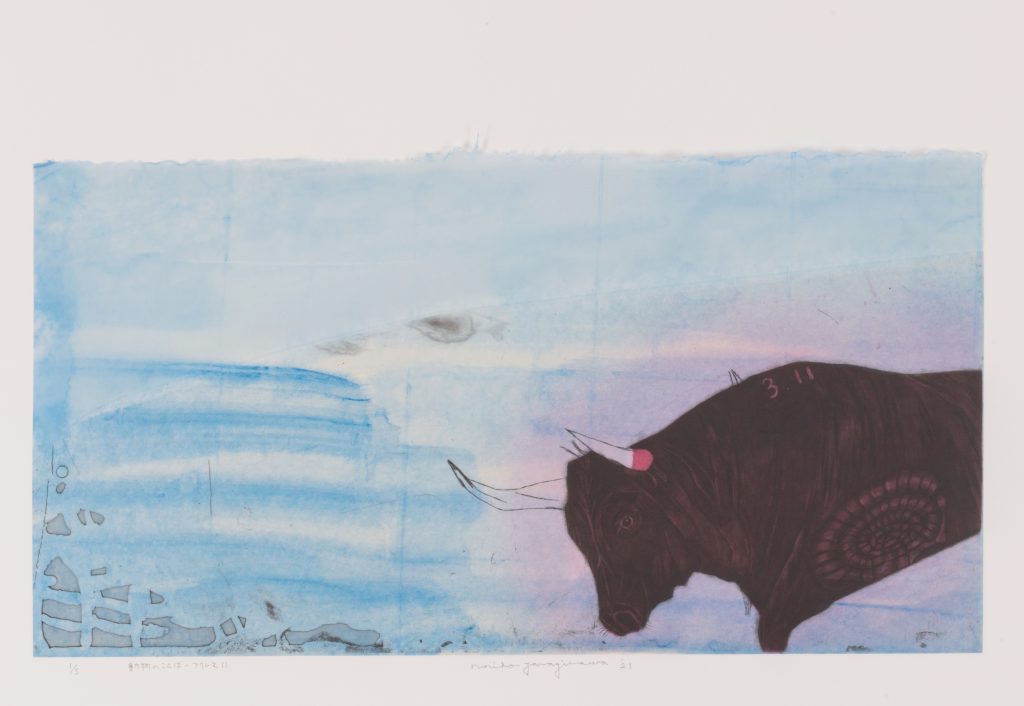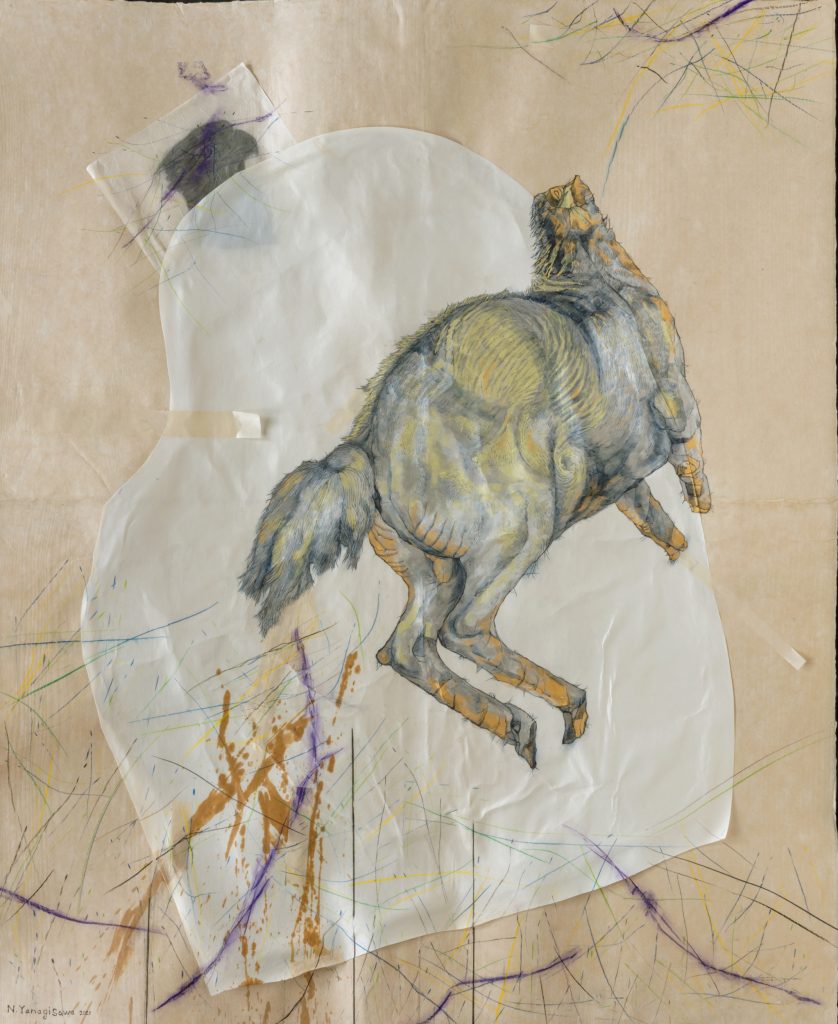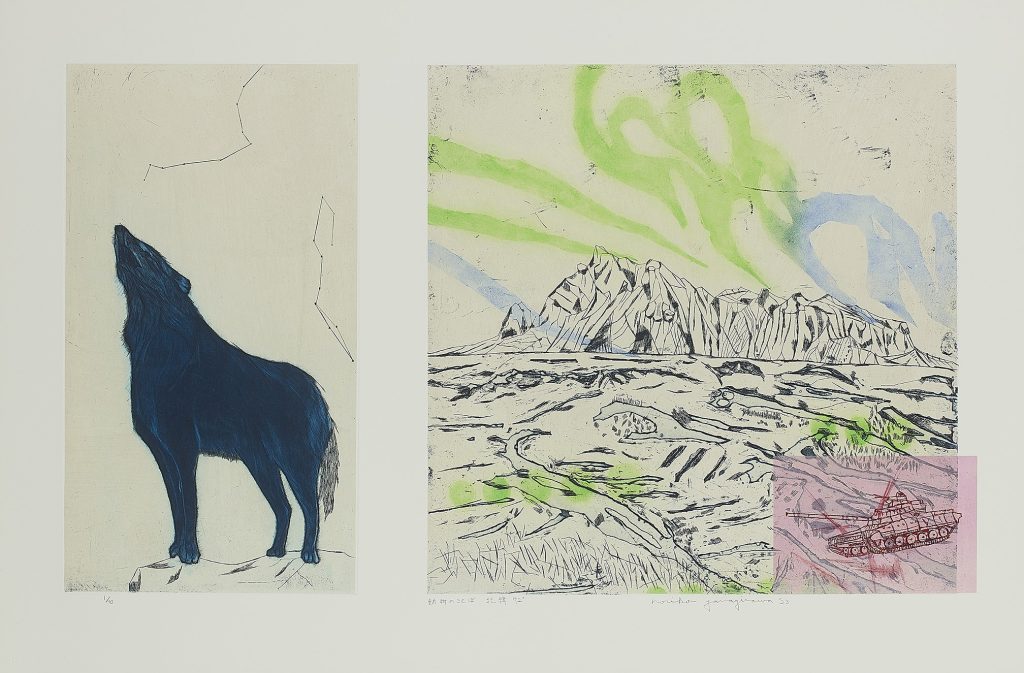柳澤紀子 YANAGISAWA Noriko

《動物のことば・MiasmaⅠ》2022年 エッチング、手染め雁皮紙、アルシュ紙、45.0×79.3㎝
Animal Words:MiasmaⅡ, 2022, Etching on Hand-dyed Gampi paper attached on Arches paper, 45.0×79.3㎝
柳澤紀子
YANAGISAWA Noriko
1940年 静岡県浜松市に生まれる。静岡県掛川市に在住、東京で活動。
沈黙と言葉――動物と人間と
鴻野わか菜 KONO Wakana
(ロシア東欧文化/早稲田大学 教育・総合科学学術院 教授)
この数年、パンデミックは世界全体に等しく降りかかり、人類は災厄のうちに、私たちは同じ星に住むひとつの共同体であることを意識した。そして、世界がパンデミックによる喪失や疲弊から癒やされないまま、2022年2月には戦争が始まった。
この困難な時代に美術はいかなる意味を持つのか。
キーウ在住で今はウクライナ西部で避難生活を送るアーティスト、ジャンナ・カディロワは、2022年3月、「戦争が始まった当時、私は芸術は夢のように儚いものだと感じた。でも今では、芸術は私たちの声を伝えるものだと思う」と語った。今年、戦争勃発に際して、多くの作家や詩人が無力感を感じ、創作の意味を再定義せざるを得ない状況に置かれた。しかし、柳澤紀子の作品もまたそれを示すように、芸術は苦境の中にあってなお、人々や時代のことばを伝えることができる。
養清堂画廊における今回の個展「動物のことば. Silence 2020–22」で展示される作品は、いずれも2020年から2022年にかけて制作され、柳澤がこれまでにも取りくみ続けてきた核、放射能、動物といった主題を発展させつつ、パンデミックや大量死というこの時代の空気を色濃く反映したものである。
連作《動物のことば・ニガヨモギ》、《動物のことば・フクシマ》(共に2021)は、タイトルが示す通り、原子力発電所の事故により放射能で汚染された土地で生きる動物たちを主題としている* 。作家は、かつて福島の避難区域で見た、やむなく置き去りにされた牛たちの姿が忘れられないと語る。2015年に訪れたチョルノブィリで作家の目を捉えたのも、人間が去った後の大地で生きる動物たちの姿だった。苛酷な状況での生を描いたこれらの作品において、動物たちは驚くほどにみずみずしく美しい。両連作の背景における乾いた薄い染みやかすれが、その土地における喪失や荒廃を表しているようであるのに対して、そこで生きる動物たちの顔や体は、汗や吐息で濡れたようにつややかで、背景とは対照的な黒く厚いマチエールが、命の重みを伝えている。光に照らしてみればその黒い肌の中には幾層ものひだがあり、それはさながら生のひだ、生命の時間を刻んだ年輪を思わせる。そして、それほどまでに美しく存在感のある動物たちの姿は、あらゆる生が奪われることの恐ろしさ、核や戦争や疫病によって奪われたひとつひとつの生の尊さに思い至らせる。
一方、連作《動物のことば・miasma》における「ミアズマ」(瘴気)は、作家が語るように今回のパンデミックを指している。本作で描かれる、地面に斃れる動物たち、あるいは人間に背負われてどこかへ運ばれていく動物たちの姿は、疫病によって翻弄される人類の姿と重なってくる。
それに対して、《動物のことば・セキガハラ》(2021)は、せきがはら人間村生活美術館での展示のために同地を訪れた作家が、関ヶ原の突き抜けるような空の高さに魅せられ、凛々しく雄大な伊吹山を背景に舞う鳥たちをイメージして制作した作品だという。柔らかく崇高な表情、そして身にまとった衣ゆえに、鷹は、鳥であると同時に、天女のような存在でもあり、作品には仏画のような宗教性が漂う。本作には、作家が動物たちの形象に託した、生きとし生けるものすべてがその生を全うし、のびやかに平和に生きられるようにという祈りが、もっとも明確に表れているように思われる。また、関が原は歴史においても地形においても分水嶺となった重要な地であり、その地名をタイトルに持つ本作も、歴史や地理の壮大な広がりを喚起する。
柳澤の作品は、現代を描きながらも、古代や中世の文明や文化を連想させる様々な要素――羊皮紙、雁皮紙といった古来からの素材や、牛の体に浮かび上がる化石のような文様――によって、原始的で若々しいアルカイックな世界にまでつながり、特定の場所や時間に限定されない無時間、多次元の空間を作り出している。《動物のことば・Silent》(2022)でも、引き裂かれた紙に浮かび上がる動物の断片的なイメージは、2万年の歳月のうちにかすれ、亀裂の走ったラスコーの壁画の動物を想起させ、生の根源としての原初の世界に通じていく。
では、これらの連作《動物のことば》における様々な動物たちは、あるいは《草土》(2020)で描かれるやせ細った犬は、どんな言葉を発し、何を語ろうとしているのか。
そこで描かれるのは、声なきものの声である。沈黙のうちに草を食み、空を舞い、野を駆け、生を営む動物たちの姿は、幾多の試練を体験しても、それでも生が続いていくこと、生き残った者は生きていかなくてはならないことを語っている。
2020年のチョルノブィリの記念日にキーウの国立タラス・シェフチェンコ美術館で始まるはずだった柳澤の個展はパンデミックのため延期となり、今では同地は戦火にさらされている。戦地では、世界に自分たちの声を伝えるために語り続ける人もいれば、あまりの悲しみに目と口と耳を閉ざし、沈黙のうちに生きる人もいる。厳しい言論統制が敷かれ、反戦を訴えることが身の危険につながるロシアでも、人々は同様に平和を願いながら、ある人は沈黙を守り、ある人は反戦のメッセージを語り続ける。しかし、たとえ沈黙せざるをえなくても、ただ懸命に生き続けることが、なによりも雄弁な「ことば」なのだということを、柳澤の描く動物は、私たちに伝えてくれる。
*「ニガヨモギ」は、「オウシュウヨモギ」(ロシア語で「チェルノブイリ」、ウクライナ語で「チョルノブィリ」)の近縁種であり、『新約聖書』の「ヨハネの黙示録」では世界の終末に空から落ちてくる星の名であることから、チョルノブィリを象徴的に指す。
『柳澤紀子 動物のことば Silence 2020-22』展カタログ、養清堂画廊、2022年に掲載。
YANAGISAWA Noriko
Born in Hamamatsu City, Shizuoka Prefecture, Japan in 1940. Lives and works in Kakegawa City, Shizuoka and in Tokyo.
Silence and Words—Animals, Humans and…
KONO Wakana (Russian and East European Culture/Professor, Faculty of Education and Integrated Arts and Sciences, Waseda University)
Over the past few years, the coronavirus pandemic swept through the entire world. This disaster allowed humanity to become aware that we are a single community living on the same planet. But in February 2022, a war broke out before we had time to heal from the losses and exhaustion caused by the pandemic.
How can art be meaningful in such difficult times?
In March 2022, Artist Zhanna Kadyrova, who lived in Kyiv, Ukraine but is currently living as a refugee in the Western Ukraine, stated, “When the war broke, I felt that the art was fragile like a dream. However, I now believe that the art will help my voice be heard.”At the outbreak of the war, artists and poets experienced a sense of powerlessness, while also being placed in a position to redefine the meaning of creativity. As if to demonstrate this, the works of Yanagisawa Noriko expressed the words of the people and the times despite adverse circumstances.
The works in this solo exhibition, Animal Words: Silence 2020–2022, held at Yoseido Gallery, were all produced between 2020 and 2022. Yanagisawa developed themes connected with nuclear and radiation issues and animals, which she has continued to pursue up until today. She has also strongly reflected the atmosphere of the times, as was the case when the pandemic and other events resulted in mass casualties.
As the series titles Animal Words: Wormwood and Animal Words: Fukushima (both produced in 2021) imply, the theme is animals that live in radioactive-contaminated lands, caused by nuclear power plant accidents. * The artist spoke about the unforgettable sight of the cows she saw, which the owners had to abandon in an evacuation zone in Fukushima. Upon her visit to Chornobyl in 2015, what caught her eye was the life of the animals in that land after its residents had left. In these series in which she depicted life under severe conditions, the animals looked surprisingly lively and beautiful. While the dry-looking, faint stains in the background expressed the sense of deprivation and devastation in those lands, the faces and bodies of the animals that inhabited the space looked shiny, as if they were moist from their own sweat and breathing. Thus, contrary to the background, the black, thick texture of the animals expressed the importance of life. When exposed to light, many layers of folds appear within the black texture. Those folds that look just like natural skin remind the viewer of the years of life the animal has lived. Furthermore, the beautiful appearances of those animals that reveal a strong sense of existence make us realize the horror of being deprived of all living beings, and the preciousness of every single one of the lives that has been taken away due to nuclear contamination, wars and the pandemic.
On the other hand, as has been referred to by the artist, the word “miasma” in the series Animal Words: Miasma refers to the coronavirus pandemic. In this series, the depiction of animals that lay dead on the ground, or those carried away on a person’s back, converge with humanity, which was at the mercy of the pandemic.
Yanagisawa, who visited Sekigahara, Gifu Prefecture for her exhibition that would be held at the Sekigahara Ningenmura Quotidian Museum of Art in 2021, was captivated by the high sky that seemed to soar above her endlessly. In contrast to Miasma, Animal Words: Sekigahara (2021) was based on the image of flying birds, with a backdrop featuring the dignified and grandeur sight of Mount Ibuki. Because the hawk in this work possesses a gentle, noble expression, and also because it is clad in clothes, the hawk is seen as a bird as well as tennyo (a celestial maiden)-like existence. This series thus conveys a religious feeling that is similar to a Buddhist picture. Out of all her series, this one most clearly expresses her prayer, which she invested in the images of animals. Namely, her prayer is for all forms of life to live out their lives, via leading carefree, peaceful lives. In addition, Sekigahara is a significant place topographically, one that featured heavily in a turning point in Japanese history. Thus, this work that adopts this placename in the title also evokes a great sense of historical and geographical scope.
Yanagisawa Noriko’s works depict the present times, while also allowing viewers to connect with a primitive and lively archaic world. She does this via various elements—such as materials used ever since ancient times, like parchment and Gampi paper, or fossil-like patterns that appear on a cow’s body—that are reminiscent of ancient and Middle-Age civilizations and cultures. This expression generates a sense of timeless and multidirectional space not limited to any specific place or time. For instance, in her series Animal Words: Silence (2022), fragmental images of animals that have seemingly surfaced on torn pieces of paper remind the viewers of the animals depicted on the cracked walls in the Lascaux cave that have blurred over 20,000 years. Those images are thus connected to the primordial world, seen as the origin of life.
One may ask then, what words are said or what is being told by the various animals depicted in the Animal Words series, or by the emaciated dogs found in the Grass Land series (2020)?
What is expressed in those works are the voices of voiceless beings. The appearances of the animals—grazing on grass, whirling in the sky, running in the field as they live their lives—are narrating the idea that life goes on despite many ordeals, and that those who have outlived others must continue to live.
Due to the COVID-19 pandemic, Yanagisawa’s solo exhibition that was to open at the National Museum Taras Shevchenko in Kyiv, Ukraine on International Chornobyl Disaster Remembrance Day in 2020 was postponed. And today, Kyiv is under the ravages of war. In the warzones, some have continued to deliver their own voices to the world, while others live within silence, as they cover their eyes, mouths and ears from too much grief. In Russia, where the severe control of free speech is being imposed upon its citizens and where an anti-war protest is liable to endanger lives, people also pray for peace; some maintain silence, while others continue to voice anti-war messages. Yanagisawa’s animals convey the message that even if people have no choice but to maintain their silence, the fight to sustain their own lives is indeed the most eloquent of “words.”
* In the Book of Revelation in the New Testament, “wormwood,” which is a related species to mugwort (in Russian, “Chernobyl;” in Ukrainian, “Chornobyl”), is the name of the star that falls from the sky at the end of the world; thus, it symbolically indicates Chornobyl.
Translated by Nanpei Taeko
YANAGISAWA Noriko, Animal Words Silence 2020-22, exhibition catalogue(in Japanese), edited by Yoseido Gallery, 2022
柳澤紀子についての新しい情報は、作家のウェブサイトをご覧ください。
Please refer to the following artist’s website for new updates.

《動物のことば・フクシマⅡ》2021年、エッチング、手染め雁皮紙、アルシュ紙、34.5×59.0㎝
Animal Words: Fukushima Ⅱ, 2021, Etching on Hand-dyed Gampi paper attached on Arches paper, 34.5×59.0㎝

《静かに草を食む》2022年 ミクストメディア、日本画顔料、羊皮紙、特厚三椏紙、134.0×109.0㎝
Grazing quietly in the meadow, 2022, Mixed media, Mineral pigment on parchment attached on Extra-thick Mitsumata paper, 134.0×109.0㎝

《動物のことば・海の庭Ⅰ》2023年 エッチング、手染め雁皮紙、アルシュ紙、64.5×59.5㎝
Animal Words: Sea field I , 2023, Etching on Hand-dyed Gampi paper attached on Arches paper, 75.5×75.8㎝

《動物のことば・北緯72°》2023年 エッチング、手染め雁皮紙、アルシュ紙、57.5×87.0㎝
Animal Words: 72°N. lat., 2023, Etching on Hand-dyed Gampi paper attached on Arches paper, 57.5×87.0㎝

《動物のことば-up right》2024年 ミクストメディア、オイルパステル、エッチング、特厚三椏紙、76.0×89.0㎝
Animal Words: up right, 2024, Mixed media, Oil pastel, Etching on Extra-thick Mitsumata paper, 76.0×89.0㎝

